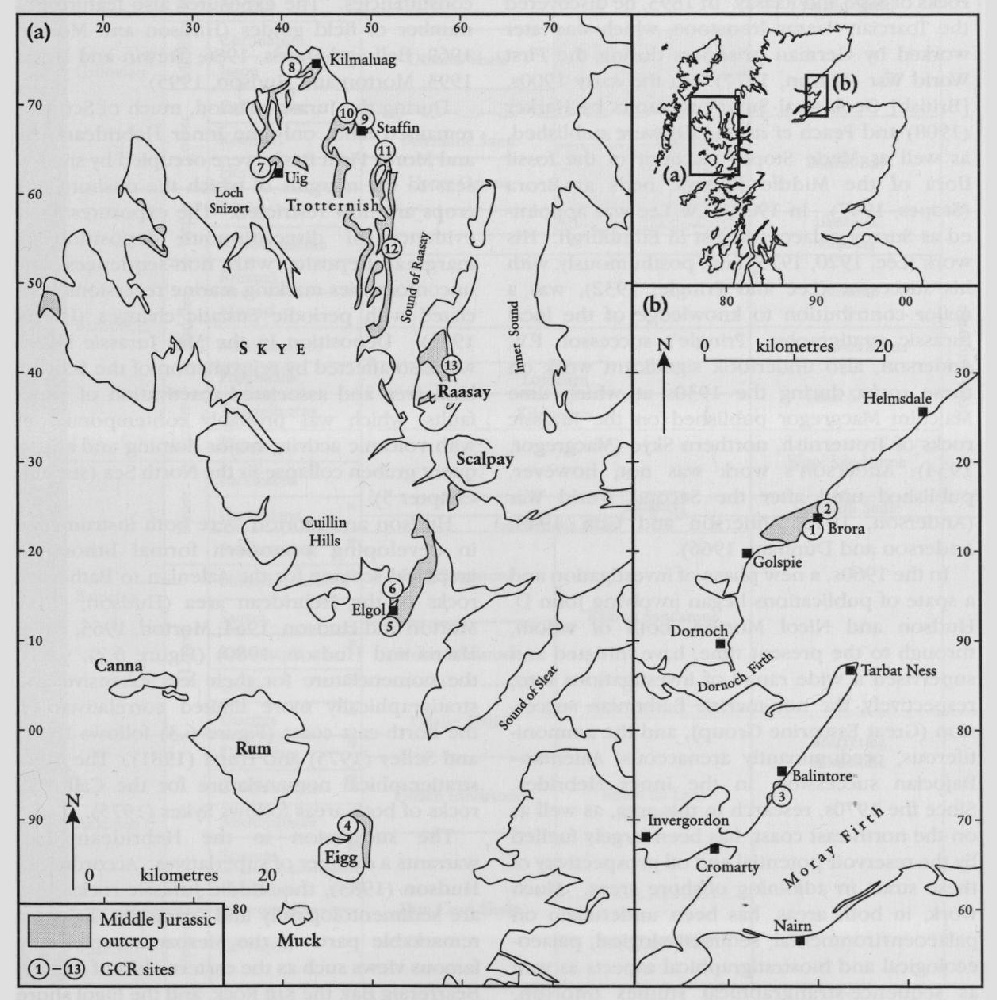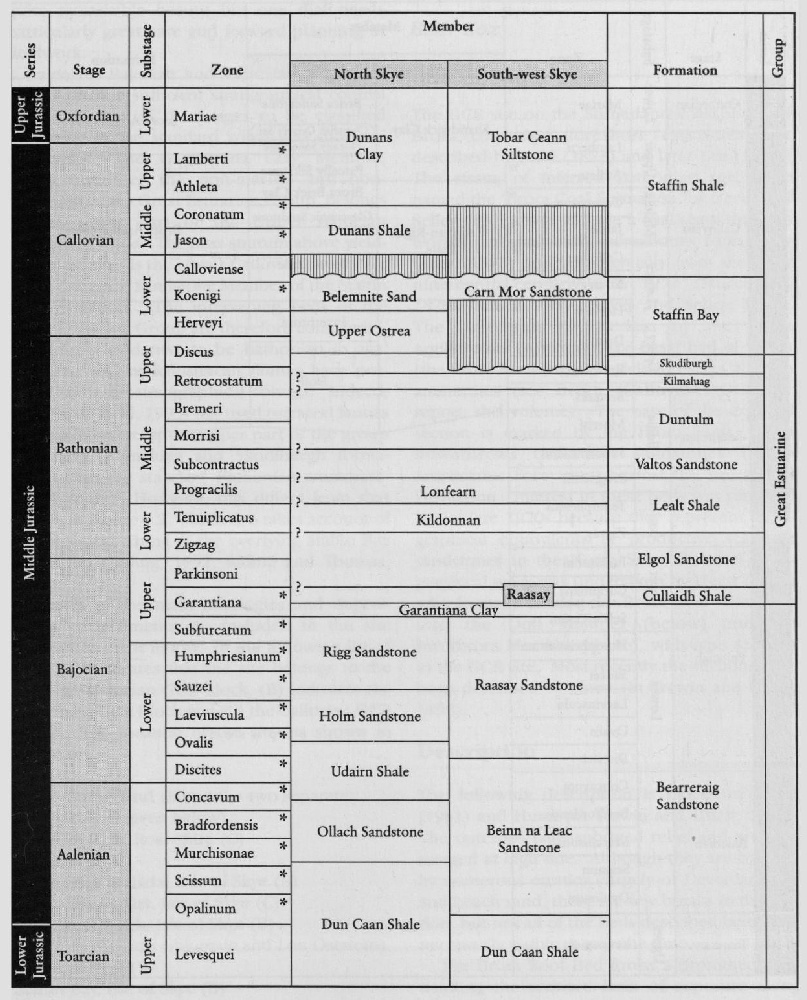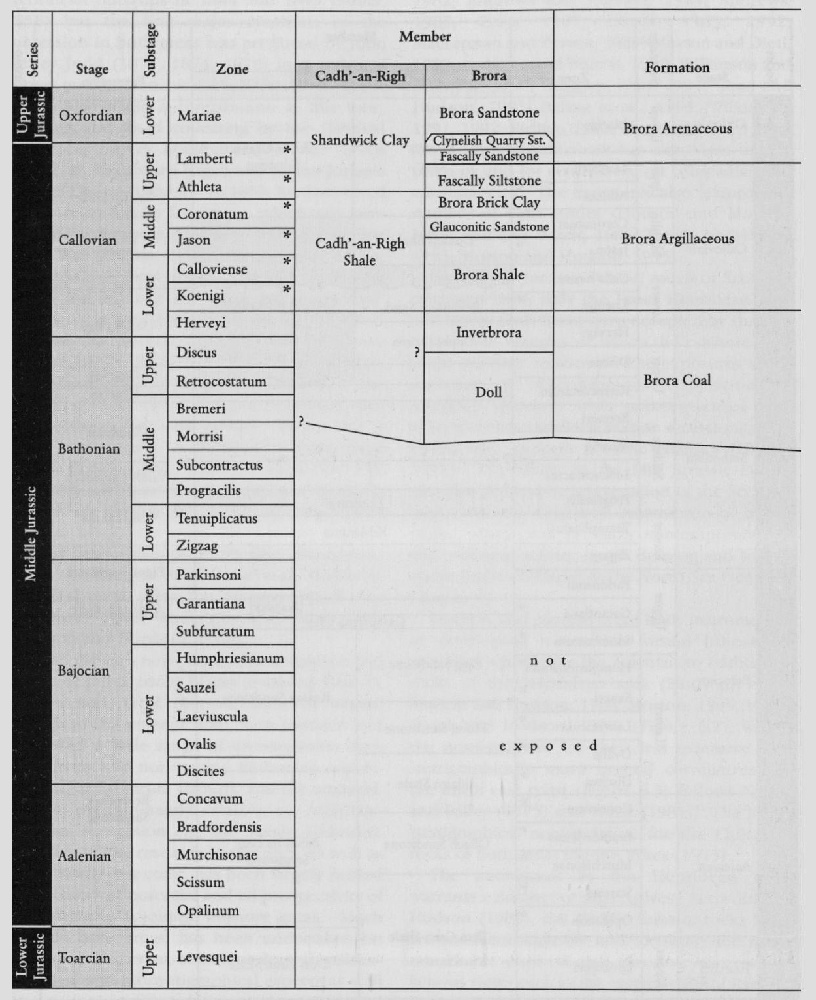Chapter 6 The Middle Jurassic stratigraphy of Scotland
B.M. Cox, K.N. Page and N Morton
Introduction
B.M. Cox
Outcrops of Middle Jurassic rocks in Scotland are restricted to the north-east coast (former counties of Sutherland and Ross and Cromarty) and mainly coastal areas of the Inner Hebridean isles off the north-west mainland (notably Skye, Raasay, Eigg and Muck) (Figure 6.1). Both areas have a long history of investigation. Anderson and Dunham (1966) noted references to the Jurassic rocks of Skye dating back to the 1770s but the first major contributions date from the early part of the 19th century when Macculloch (1819) and Murchison (1829a,b), and later Forbes (1851), produced pioneer geological accounts. Hugh Miller (Cromarty stonemason, geologist and popular writer) visited the Hebridean outcrops in 1844 and 1845 (Miller, 1858) but the first major synthesis of the succession in both areas was produced by John Wesley Judd (1873, 1874, 1878) in a series of papers on the Mesozoic rocks of Scotland. Bryce (1873) also made a contribution at this time. Mapping and fossil collecting by the [British] Geological Survey commenced in the 1890s when H.B. Woodward began to map the Jurassic rocks of Skye and Raasay. In 1893, he discovered the Toarcian Raasay Ironstone, which was later worked by German prisoners during the First World War (Wilson, 1977). In the early 1900s, [British] Geological Survey memoirs by Harker (1908) and Peach et al. (1910) were published, as well as Marie Stopes' account of the fossil flora of the Middle Jurassic beds at Brora (Stopes, 1907). In 1907, G.W. Lee was appointed as Survey palaeontologist in Edinburgh. His work (Lee, 1920, 1925) and, posthumously, with his successor (Lee and Pringle, 1932), was a major contribution to knowledge of the local Jurassic stratigraphy. Pringle's successor, F.W. Anderson, also undertook significant work on these rocks during the 1930s at which time Malcolm Macgregor published on the Jurassic rocks of Trotternish, northern Skye (Macgregor, 1934); Anderson's work was not, however, published until after the Second World War (Anderson, 1948; Anderson and Cox, 1948; Anderson and Dunham, 1966).
In the 1960s, a new phase of investigation and a spate of publications began involving John D. Hudson and Nicol Morton, both of whom, through to the present time, have initiated and supervised a wide range of investigations into, respectively, the non-marine Bathonian succession (Great Estuarine Group), and the ammoni-tiferous, predominantly arenaceous, Aalenian–Bajocian succession, in the Inner Hebrides. Since the 1970s, research in this area, as well as on the north-east coast, has been largely fuelled by the reservoir potential and oil prospectivity of these strata in adjoining offshore areas. Much work, in both areas, has been undertaken on palaeoenvironmental, sedimentological, palaeoecological and biostratigraphical aspects as well as sequence-stratigraphical studies (Morton, 1971, 1972, 1973, 1975, 1976, 1983a,b,1984, 1988, 1989, 1990, 1991, 1994; Savage,,1972; Waldman and Savage, 1972; Neves and Selley, 1975; Sykes, 1975; Hudson and Harris, 1979; Harris and Hudson, 1980; Hudson, 1980, 1983; Hurst, 1981, 1982, 1985; Bradshaw and Fenton, 1982; Andrews and Hudson, 1984; Andrews, 1985, 1986, 1987; Harris, 1989, 1992; MacLennan and Trewin, 1989; Morton and Dietl, 1989; Andrews and Walton, 1990; Wilkinson and Dampier, 1990; Gregory, 1990, 1991; Chen and Hudson, 1991; Riding et al., 1991; Wilkinson, 1991, 1992; Riding, 1992; Hudson et al., 1995). Much unpublished work has also been undertaken by and for commercial oil companies and consultancies. The exposures also feature in a number of field guides (Hudson and Morton, 1969; Bell and Harris, 1986; Trewin and Hurst, 1993; Morton and Hudson, 1995).
During the Jurassic Period, much of Scotland remained land; only the Inner Hebridean area and Moray Firth Basin were occupied by shallow seas to the margins of which the onshore outcrops are now restricted. The exposures show evidence of discontinuous deposition of marginal deposits with non-sequences and unconformities marking marine recessions associated with periodic eustatic changes (Harris, 1991). Deposition in the Mid Jurassic Epoch was also affected by rejuvenation of the Scottish land area and associated reactivation of major faults, which was probably contemporaneous with volcanic activity, major doming and subsequent graben collapse in the North Sea (see also Chapter 5).
Hudson and Morton were both instrumental in developing a modern formal lithostratigraphical scheme for the Aalenian to Bathonian rocks of the Hebridean area (Hudson, 1962; Morton and Hudson, 1964; Morton, 1965, 1976; Harris and Hudson, 1980) (Figure 6.2), whilst the nomenclature for their less extensive and stratigraphically more limited correlatives on the north-east coast (Figure 6.3) follows Neves and Selley (1975) and Hurst (1981). The lithostratigraphical nomenclature for the Callovian rocks of both areas follows Sykes (1975).
The succession in the Hebridean area warrants a number of superlatives. According to Hudson (1983), the Middle Jurassic rocks here are sedimentologically and scenically the most remarkable parts of the Mesozoic succession; famous views such as the eastern cliffs of Raasay; Bearreraig Bay, the Kilt Rock, and the Elgol shore with its backdrop of the Cuillins, on Skye; and the Bay of Laig on Eigg, all feature rocks of this age. The Bearreraig Sandstone Formation includes the thickest sandstone in the British Jurassic succession, and the Great Estuarine Group is the thickest and most varied development of its paralic facies. The area is one of quite remarkable beauty, but one that needs particularly great care and forward planning in fieldwork.
Aalenian, Bajocian and Callovian ammonite faunas provide sufficient stratigraphical control to allow rocks of these ages to be classified according to the standard zonal and subzonal schemes. The Garantiana Clay Member, which underlies the non-marine and non-ammonitiferous Great Estuarine Group, belongs to the lower part of the Upper Bajocian Garantiana Zone. The next stratum above yielding ammonites is the Lower Callovian Belemnite Sand–Carn Mor Sandstone Member of the Staffin Bay Formation. The intervening beds of the Great Estuarine Group are therefore considered, on indirect evidence, to be Bathonian in age. Ostracod and conchostracan faunas have provided some biostratigraphical control. Indeed, Wakefield (1994, 1995) has used ostracod faunas to correlate at least the upper part of the group (Duntulm, Kilmaluag and Skudiburgh formations) with the standard Bathonian ammonite-based zones. However, this differs from that shown in (Figure 6.2), which also takes account of palynological dating of the overlying Staffin Bay Formation (Riding, 1992; Riding and Thomas, 1997).
Details of the main lithologies and depositional environments are included in the site descriptions that follow. In the following list of sites, (A) indicates that the site belongs to the Aalenian–Bajocian GCR Block, (B) indicates the Bathonian GCR Block and (C) the Callovian GCR Block. The location of the sites is shown in (Figure 6.1).
Brora, Sutherland (B and C — two separate reports are given below)
Cadh'-an-Righ, Ross-Shire (C)
Isle of Eigg (B)
Elgol–Glen Scaladal, Isle of Skye (B)
North Elgol coast, Isle of Skye (C)
Dun Skudiburgh, Isle of Skye (B)
Duntulm (Cairidh Ghlumaig and Lon Ostatoin), Isle of Skye (B)
Staffin Bay, Isle of Skye (B)
Staffin, Isle of Skye (C)
Valtos, Isle of Skye (B)
Bearreraig Bay, Isle of Skye (A)
Beinn na Leac, Isle of Raasay (A)
References



